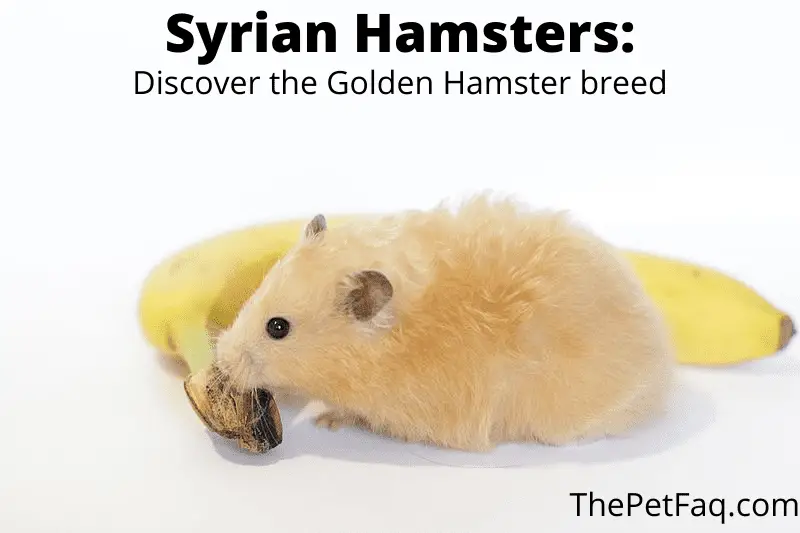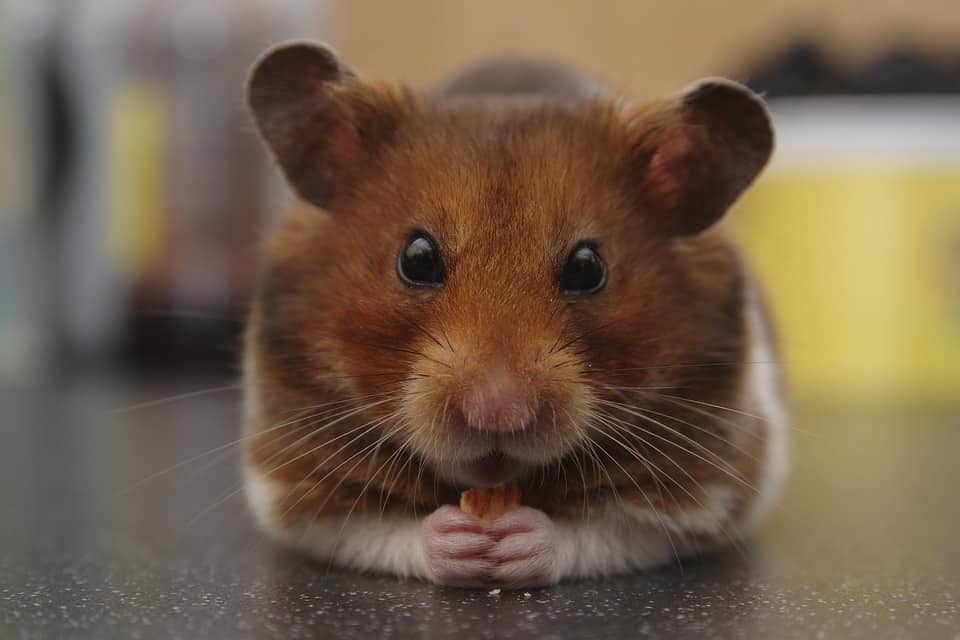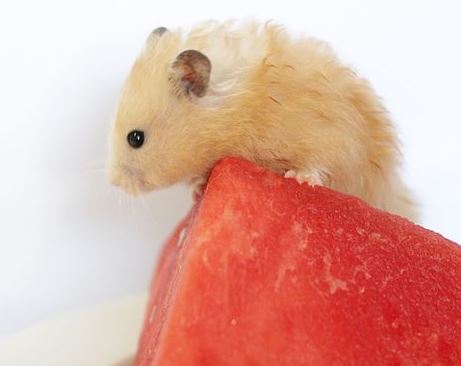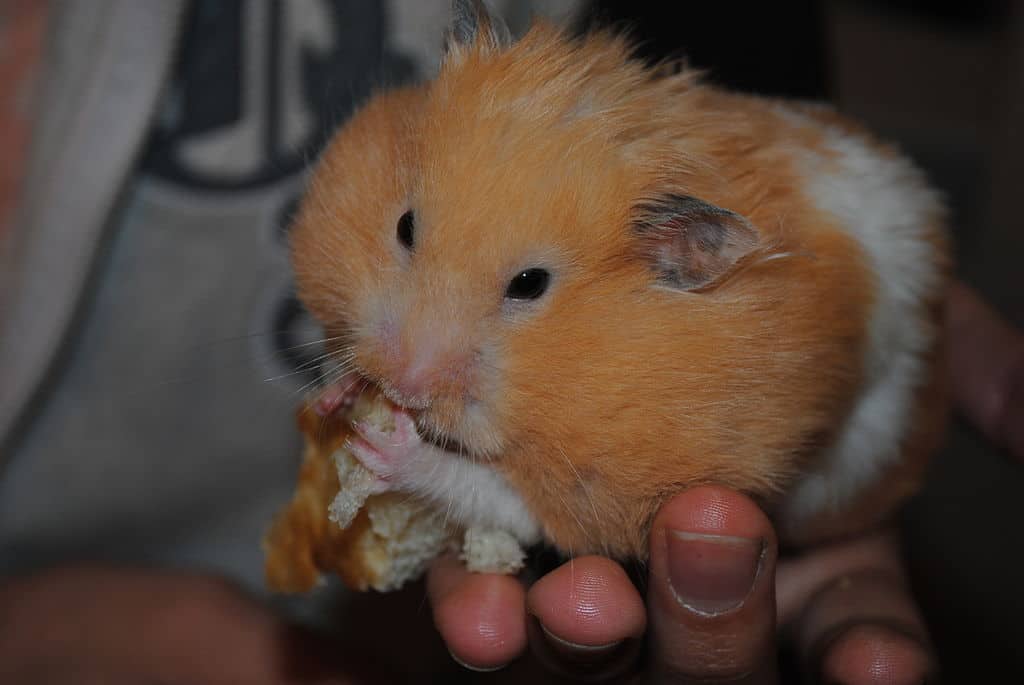When most people hear the word “hamster” they think of the Syrian hamster. It’s by far the most popular and well-known hamster breed, and for good reason. Their affectionate, social, and energetic nature combined with their adorable appearance, makes them beloved pets across the world.
In addition, they’re quite easy to care for due to their straightforward diet, low grooming requirements, and generally low-maintenance nature.

Nevertheless, while Syrian hamsters are not the most complicated pets, there’s still a lot to learn when it comes to caring for these loveable creatures. Today, we’re going to go over everything you need to know to give the Syrian hamster the loving home it deserves, let’s dig in.
Syrian Hamster Fact Sheet
| Name(s) | Syrian Hamster, Golden Hamster |
| Length | 6 inches |
| Weight | 3.5 to 5 ounces, can be heavier in captivity |
| Experience required | Great for beginners |
| Lifespan | 2 to 3 years |
| Temperament | Affectionate, docile, good-natured, inquisitive, energetic |
| Colors and patterns | Wide variety of colors and patterns. Most commonly golden, but can also be black, gray, chocolate, cinnamon, and other colors. |
| Coat | Long or short, can be curly (rex) or straight (satin) |
| Should be kept alone | Yes |
What is a Syrian Hamster exactly?
Syrian hamsters are the largest pet hamster breed, being up to 5 times larger than the smaller dwarf hamsters. They are also referred to as Golden Hamsters, in reference to their stunning coat color.
They’re native to arid regions in Syria and Turkey, where they were first formally discovered in 1797 when they were described in the book The Natural History of Aleppo.
After being discovered and subsequently captured, they made their way to the west. There, breeding programs popped up and they started becoming popular as small household pets due to their cute appearance and good nature.
Nowadays, Golden Hamsters still exist in the wild, but most of them live as pets.
Appearance of the Syrian Hamster 🐹

Syrian hamsters are small rodents usually around 6 inches in length and weigh between 3.5 and 5 ounces in the wild, but in captivity, they can weigh more than that. They’re characterized by their cheek pouches, which they use to transport food.
Most Syrians are a golden brown color with a lighter belly but selective breeding has given rise to a wide range of different colors. Colors that they can have include:
- Golden
- Umbrous Golden
- Black-eyed cream
- Red-eyed cream
- Sable
- Black
- Mink
- Cinnamon
- Gray
- Chocolate
- Yellow
- Yellow black
In addition, they can have a large variety of different patterns, such as:
- Roan
- Banded
- Dominant spot
- Tortoiseshell
To make them even more unique, Syrian hamsters can also have the following different coat types.
- Satin (straight, smooth coat)
- Rex (curly coat)
And if that wasn’t enough, they can also be long-haired or short-haired!
As you can see, Syrians come in a very diverse range of colors, patterns, and coats. This is great because it makes every hamster unique and gives you a lot of options to choose from when picking out your new best friend.
Temperament of the Syrian Hamster
Syrian hamsters are typically affectionate towards humans. Compared to dwarf hamster breeds, Syrians are much less shy, more friendly, and not as afraid. This is probably due to their larger size. They enjoy spending time with their humans and can form strong bonds with their owners.
Nevertheless, while they’re not as easily frightened as dwarf hamsters, they’re still relatively small prey animals. As a result, they still have fearful instincts. When handling a Syrian hamster, approach them calmly. If they’re scared or startled, they might bite.
Golden hamsters are also very inquisitive and active animals. They love discovering new places and are little balls of energy. They can run up to 9 miles a day, which is a very impressive distance for such a small rodent! Because they’re quite active, they need an owner who can keep up with them.
Another important thing to note is that these hamsters are nocturnal. This means that they sleep during the day and wake up around twilight. Their nocturnal nature combined with their high-energy levels means that they’re quite active at night and can produce a decent amount of night-time noise.
While Golden hamsters are friendly towards humans, they’re not friendly towards other hamsters. They’re solitary, territorial animals and do not like sharing their cage with anyone. Make sure that you do not put a Syrian in a cage with another hamster. Their territorial nature will kick in and it will lead to fights. These fights can have fatal outcomes, so don’t try it!
Caring for Syrian hamsters

Goldens are not particularly difficult to care for. Their diet, housing, and grooming needs are not all that challenging, which makes them a great fit for beginner pet owners or children.
Nevertheless, while caring for them is not the most difficult task, this is only true if you know what you’re doing. Therefore, it’s important to know the basics.
What do Syrian hamsters eat? 🥦

The vast majority of your Syrian hamster’s food intake should come from commercial pellets. These pellets are created to contain the most important nutrients for your hamster. About 80 to 90% of your hamster’s daily food intake should come from these pellets. Choose pellets that contain between 15 and 20% protein, such as Oxbow’s Healthy Handfuls.
Generally speaking, Syrian hamsters should eat about 12 grams (one tablespoon) of food per day to stay at a healthy weight.
In addition to pellets, they can eat small quantities of fruits and vegetables. Furthermore, since hamsters are omnivores, you can also give them the occasional piece of meat, fish, or insect as a treat.
Some treats that Syrian hamsters enjoy eating include:
- Fruits: Apples, pears, strawberries, blueberries, watermelon
- Vegetables: Carrots, broccoli, squash, cauliflower, cucumber
- Others: Walnuts, chicken, turkey, mealworms, hard-boiled egg
Housing a Syrian hamster 🏡

Creating a safe, comfortable, and cozy habitat for your hamster is very important. It gives them a place to relax and be comfortable away from all the noise and excitement of daily life.
Wire cages with a plastic bottom make good homes for Syrian hamsters. Make sure that their cage has at least 1500 square inches of floor space. If you can get your hands on a bigger cage, that’s great! Bigger cages are almost always the better option.
An important thing to look out for when buying a cage is bar spacing. For Goldens, the space between the bars should be no more than half an inch to prevent escape while still giving them the opportunity to climb if they so desire.
A good place to put their cage is out of direct sunlight in an area with good ventilation. Avoid drafty or damp areas.
Bedding
To make their cage comfortable for your Syrian hamster, it will need a couple of inches of bedding. Bedding made from paper products or aspen shavings is recommended. Avoid cedar or pine bedding. The strong smell can irritate your hamster’s airways.
Cage essentials
Of course, an empty house is not a home. To make your hamster feel at home, you’ll need to decorate it. The way you decorate the cage is largely up to you, but there are some things that are essential for your hamster to have in their cage.
- Exercise Wheel. Make sure to use a wheel that has a solid surface, not one made of bars to prevent injuries.
- Food bowl and water bottle
- Chew toys
- Huts/houses
Grooming your Syrian Hamster ✂️
Syrian hamsters are very clean animals. They spend a large portion of their day cleaning themselves. Because of this, grooming them is relatively simple. They do not need baths. If you do notice that a certain spot on your hamster is getting a little dirty, wiping them clean with a moist cloth will do the trick.
Long-haired golden hamsters do require some brushing every now and then to prevent them from getting knots and mats in their long hair, whereas the short-haired variant does not require brushing.
The best thing you can do to help your hamster stay clean is to keep its cage fresh. Fully clean their cage at least once every two weeks for optimal results. Additionally, you can also place a sand bath in their habitat. Syrians are not as fond of sand baths as dwarf hamsters, but it doesn’t hurt to give them the option to use it.
Health & Lifespan
Syrian hamsters are generally healthy animals. On average, they live for 2 to 3 years in captivity. However, with good care, they can live quite a bit longer. The oldest hamster on record lived for four and a half years!
Golden hamsters do not suffer from a whole lot of ailments but there are a few common issues that you should keep an eye out for.
- Wet tail. Wet tail is caused by a bacterial infection. The symptoms are diarrhea and a lack of appetite. It often affects younger hamsters but can occur in hamsters of any age as a result of a bacterial infection. If you’re concerned that your Syrian hamster has wet tail, take it to a vet immediately because it can be lethal if not treated.
- Overgrown teeth. Hamsters are rodents, as such, their teeth never stop growing. To keep their teeth in check, they grind them down. The best way for your hamster to grind down its teeth is through chew toys. Make sure that they always have access to chew toys to prevent their teeth from growing too long.
Taming a Syrian hamster

Syrian hamsters are not particularly hard to tame. They respond well to humans, especially if you start when they’re still young.
The best way to start is by first letting them get used to your smell and presence. You can do this by placing your hand in their cage and letting them sniff it. You can also offer them treats when doing this so that they associate your smell with positive emotions. Once they’re used to your smell and presence and learn that you’re not a threat they will be much more receptive to being touched. Once they’re comfortable with being touched and petted you can try picking them up.
Do be careful when picking them up that you do not drop them. Make sure that you only hold them close to the ground so that if you do accidentally drop them they’re not harmed. Also, make sure that they do not try to escape when handling them. If they escape they often do not return to their cage and it’s not easy to find a hamster because they’re experts at hiding.
Hamsters can learn many tricks and commands if properly trained. Reinforce good behavior with treats and you’ll be able to teach your golden hamster almost anything!
Buying a Syrian hamster
One of the best things about hamsters is that they’re quite cheap. Buying a hamster from a breeder typically only costs around $20 to $30. Another option is buying from a pet shop. This is cheaper, but not recommended.
The hamsters that are for sale in pet shops often come from rodent mills and are not ethically bred. Reputable, good breeders, on the other hand, take excellent care of the hamsters they sell. They feed them a good diet and socialize them properly. By buying from an ethical breeder you not only support ethical breeding, but you’re also much more likely to get a more social and healthier hamster!
Of course, you should also consider the upkeep cost of owning a hamster. On average taking care of a hamster costs about $40 a month for food, vet bills, bedding, and toy replacements.
Frequently asked questions
Do Syrian hamsters enjoy being held?
Because Syrians are the most affectionate hamster breed they usually do enjoy being held as long as they’re well-tamed.
Do Syrian hamsters like the dark?
Since hamsters are nocturnal they enjoy the dark. The primary reason for this is that they’re prey animals. They enjoy the cover of night because in the wild it helped them hide from predators.
Final words: Is a Syrian the right hamster breed for you?
Syrian hamsters are excellent pets. The fact that they’re relatively easy to care for due to their straightforward diet, low grooming requirements, and easy-going temperament makes them a great pet for older children as well as adults.
Their affectionate and docile nature makes them easy to tame and their large variety of different colors and patterns makes sure that there’s something for everyone.
If you’re not convinced that the Syrian hamster is the right breed for you, you might be interested in learning more about these other hamster breeds:
- How Long Do American Eskimo Dogs Live? Important Factors and Care Tips - September 29, 2023
- Do American Bulldogs Need Grooming? Essential Tips and Care Guidelines - September 29, 2023
- Do Bengal Cats Enjoy Playing? Essential Tips for Keeping Them Active - September 29, 2023